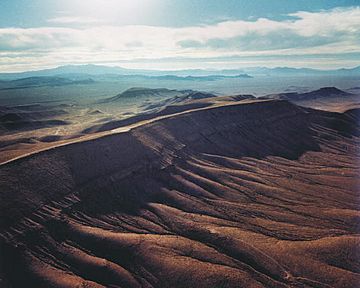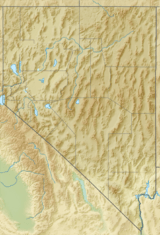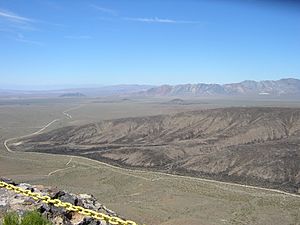Yucca Mountain facts for kids
Quick facts for kids Yucca Mountain |
|
|---|---|

Yucca Mountain
|
|
| Highest point | |
| Elevation | 6,707 ft (2,044 m) NAVD 88 |
| Prominence | 1,333 ft (406 m) |
| Geography | |
| Topo map | USGS Topopah Spring |
| Geology | |
| Mountain type | Caldera, cinder cones |
| Last eruption | 80,000 years ago |
Yucca Mountain is a mountain in Nevada, a state in the western United States. It is close to the border with California. The mountain is about 100 miles (160 km) northwest of Las Vegas.
Yucca Mountain is part of the Great Basin region. It is located east of the Amargosa Desert. It is also south of the Nevada Test and Training Range. The mountain is within the Nevada National Security Site.
This mountain is known because it was chosen by law to be the place to store the nation's used nuclear waste. This waste comes from nuclear power plants. However, the plan to store waste there was stopped in 2010. This happened because of political decisions, even though the site was being reviewed.
Contents
What is Yucca Mountain Made Of?
Yucca Mountain was formed by several very large volcanic eruptions. These eruptions created layers of rock. The rock is called ignimbrite or tuff. Some layers are hard and welded together. Others are softer.
The rock layers have been tilted by fault lines. This tilting created the mountain's shape. Yucca Mountain also has many cracks. Many of these cracks formed as the volcanic rock cooled down.
How Did Yucca Mountain Form?
Millions of years ago, huge volcanic eruptions happened north of Yucca Mountain. These eruptions sent out thick clouds of ash and rock. This material then cooled and pressed together. It formed the layers of rock called tuff. These layers make up the mountains and hills in the area.
The big volcanic eruptions that created Yucca Mountain ended about 12 million years ago. These powerful eruptions made almost all (more than 99%) of the volcanic material in the region.
When Was the Last Volcanic Activity?
A different type of volcanic eruption started several million years ago. These eruptions were smaller and less explosive. They involved lava and cinders slowly coming out of cones or cracks.
The most recent small eruption happened about 80,000 years ago. This kind of eruption created less than one percent of the volcanic material. Yucca Mountain is next to an area called Crater Flat. This area has several small volcanic cones.
Who Lived Near Yucca Mountain?
Yucca Mountain and the lands around it were very important to two Native American groups. These were the Western Shoshone and Southern Paiute peoples. They used the land for religious events and to gather resources. They also held social gatherings there.
Today, the Shoshone people still consider Yucca Mountain a sacred place. It holds deep spiritual meaning for them.
Images for kids
See also
 In Spanish: Yucca Mountain para niños
In Spanish: Yucca Mountain para niños





